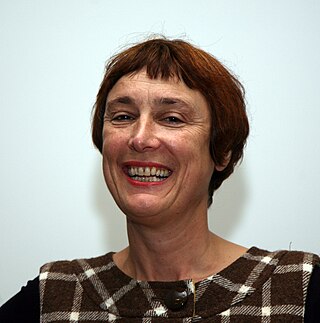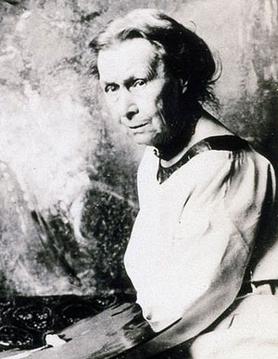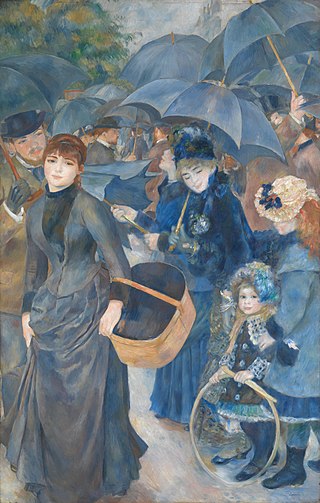Related Research Articles

Johannes Vermeer was a Dutch Baroque Period painter who specialized in domestic interior scenes of middle-class life. He is considered one of the greatest painters of the Dutch Golden Age. During his lifetime, he was a moderately successful provincial genre painter, recognized in Delft and The Hague. He produced relatively few paintings, primarily earning his living as an art dealer. He was not wealthy; at his death, his wife was left in debt.

Joseph Mallord William Turner, known in his time as William Turner, was an English Romantic painter, printmaker and watercolourist. He is known for his expressive colouring, imaginative landscapes and turbulent, often violent marine paintings. He left behind more than 550 oil paintings, 2,000 watercolours, and 30,000 works on paper. He was championed by the leading English art critic John Ruskin from 1840, and is today regarded as having elevated landscape painting to an eminence rivalling history painting.

Tracey Karima Emin is an English artist known for autobiographical and confessional artwork. She produces work in a variety of media including drawing, painting, sculpture, film, photography, neon text and sewn appliqué. Once the "enfant terrible" of the Young British Artists in the 1980s, Tracey Emin is now a Royal Academician.

Bridget Louise Riley is an English painter known for her op art paintings. She lives and works in London, Cornwall and the Vaucluse in France.

Lucian Michael Freud was a British painter and draughtsman, specialising in figurative art, and is known as one of the foremost 20th-century English portraitists. He was born in Berlin, the son of Jewish architect Ernst L. Freud and the grandson of Sigmund Freud. Freud got his first name "Lucian" from his mother in memory of the ancient writer Lucian of Samosata. His family moved to England in 1933, when he was 10 years old, to escape the rise of Nazism. He became a British naturalized citizen in 1939. From 1942 to 1943 he attended Goldsmiths' College, London. He served at sea with the British Merchant Navy during the Second World War.

Laurence Stephen Lowry was an English artist. His drawings and paintings mainly depict Pendlebury, Greater Manchester as well as Salford and its vicinity.
Jennifer Anne Saville is a contemporary British painter and an original member of the Young British Artists. Saville works and lives in Oxford, England and she is known for her large-scale painted depictions of nude women. Saville has been credited with originating a new and challenging method of painting the female nude and reinventing figure painting for contemporary art. Some paintings are of small dimensions, while other are of much larger scale. Monumental subjects come from pathology textbooks that she has studied that informed her on injury to bruise, burns, and deformity. John Gray commented: "As I see it, Jenny Saville's work expresses a parallel project of reclaiming the body from personality. Saville worked with many models who under went cosmetic surgery to reshape a portion of their body. In doing that, she captures "marks of personality for the flesh" and together embraces how we can be the writers of our own lives."
Dame Sonia Dawn Boyce is a British Afro-Caribbean artist and educator, living and working in London. She is a Professor of Black Art and Design at University of the Arts London. Boyce's research interests explore art as a social practice and the critical and contextual debates that arise from this area of study. Boyce has been closely collaborating with other artists since 1990 with a focus on collaborative work, frequently involving improvisation and unplanned performative actions on the part of her collaborators. Boyce's work involves a variety of media, such as drawing, print, photography, video, and sound. Her art explores "the relationship between sound and memory, the dynamics of space, and incorporating the spectator". To date, Boyce has taught Fine Art studio practice for more than 30 years in several art colleges across the UK.

Elisabetta Sirani was an Italian Baroque painter and printmaker who died in unexplained circumstances at the age of 27. She was one of the first women artists in early modern Bologna, who established an academy for other women artists.

Cornelia Ann Parker is an English visual artist, best known for her sculpture and installation art.
Eileen Cooper is a British artist, known primarily as a painter and printmaker.

The Last of England is an 1855 oil-on-panel painting by Ford Madox Brown depicting two emigrants leaving England to start a new life in Australia with their baby. The painting has an oval format and is in the Birmingham Museum and Art Gallery.
Laila Shahzada was a Pakistani abstract painter who lived and worked in Karachi, Pakistan.

Annie Louisa Swynnerton, ARA was a British painter best known for her portrait and symbolist works. She studied at Manchester School of Art and at the Académie Julian, before basing herself in the artistic community in Rome with her husband, the monumental sculptor Joseph Swynnerton. Swynnerton was influenced by George Frederic Watts and Sir Edward Burne-Jones. John Singer Sargent appreciated her work and helped her to become the first elected woman member at the Royal Academy of Arts in 1922. Swynnerton painted portraits of Henry James and Millicent Fawcett. Her main public collection of works are in Manchester Art Gallery, but individual works are also held in a few other English cities, as well as can also be seen in Glasgow, Dublin, Paris, and two in Melbourne, Australia. Annie was a close friend of leading suffragists of the day, notably the Pankhurst family.

The Umbrellas is an oil-on-canvas painting by Pierre-Auguste Renoir, painted in two phases in the 1880s. It is owned by the National Gallery in London as part of the Lane Bequest but is displayed alternately in London and at the Dublin City Gallery The Hugh Lane. From May 2013 to 2019, it returned to Dublin for a six-year period. It is now in the National Gallery London.

Carla Gannis is an American transmedia artist based in New York and professor at the Pratt Institute in the Department of Digital Arts until 2019 when she joined New York University. Her works combine digital imagery with well-known works of art such as paintings by Pieter Bruegel the Elder. She received widespread attention in 2013 for her emoji version of Hieronymus Bosch's painting The Garden of Earthly Delights.

Fanny Eaton was a Jamaican-born artist's model and domestic worker. She is best known as a model for the Pre-Raphaelite Brotherhood and their circle in England between 1859 and 1867. Her public debut was in Simeon Solomon's painting The Mother of Moses, which was exhibited at the Royal Academy in 1860. She was also featured in works by Dante Gabriel Rossetti, John Everett Millais, Joanna Mary Boyce, Rebecca Solomon, and others.
Ghislaine Howard is a figurative artist who works with paint to describe the human figure and the universal experiences of the human condition.

Annie Morris is a British artist based in London.
References
- ↑ "British Bengali Success Stories". BritBangla. 2003. Retrieved 1 December 2012. Sanchita Islam
- ↑ "BBC World News Amit Choudhury and Sanchita Islam on Impact". BBC World News. 6 June 2013. Retrieved 1 February 2014.
- 1 2 "Sanchita Islam". Millionaires Saving Migrants. BBC World Service. 19 February 2015. Retrieved 1 May 2015.
- ↑ Marino, Elisabetta (7 January 2012). "Bridging Gaps: an interview with Sanchita Islam". The Creative Case for Diversity. p. 3. Retrieved 1 December 2012.
- 1 2 Amin, Aasha Mehreen (30 April 2004). "A Different Face of Islam". The Daily Star . Bangladesh. Retrieved 1 December 2012.
- 1 2 3 4 5 "Sanchita Islam". Hix. Retrieved 1 December 2012.
- 1 2 Marino, Elisabetta (7 January 2012). "Bridging Gaps: an interview with Sanchita Islam". The Creative Case for Diversity. p. 2. Retrieved 1 December 2012.
- 1 2 3 4 5 6 "Sanchita Islam". Cultural Co-operation. Retrieved 1 December 2012.
- 1 2 3 "Sanchita Islam". Open Gallery. 2007. Retrieved 1 December 2012.
- 1 2 Marino, Elisabetta (7 January 2012). "Bridging Gaps: an interview with Sanchita Islam". The Creative Case for Diversity. p. 1. Retrieved 1 December 2012.
- ↑ "State of Independenz – Sanchita Islam". London College of Fashion. 3 October 2007. Archived from the original on 22 December 2012. Retrieved 1 December 2012.
- ↑ "Sanchita Islam". The Huffington Post . Retrieved 5 May 2015.
- ↑ "Sanchita Islam: The Rebel Within". March 2013. Retrieved 1 May 2015.
- ↑ "Sanchita Islam". BBC Asian Network. 17 March 2013. Retrieved 1 August 2015.
- ↑ "Schizophrenics Can be Good Mothers Too". Muswell Hill Press. October 2014. Retrieved 1 May 2015.
- ↑ "Schizophrenics Can be Good Mothers Too". June 2015. Retrieved 1 May 2015.
- ↑ O'Hara, Mary (16 June 2015). "Sanchita Islam on mothers and mental health: 'Women suffer visions in silence'". The Guardian . Retrieved 1 July 2015.
- ↑ "Sanchita Islam, 50: Painter, writer and musician who viewed art as a cure". The Times . 22 February 2024. ISSN 0140-0460 . Retrieved 22 February 2024.